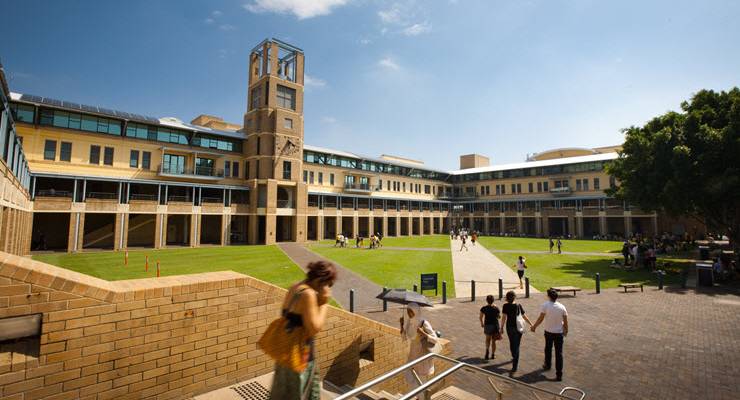
The University of NSW (UNSW) has announced it will be cutting nearly 500 jobs, in the latest sign of the carnage inflicted on the higher education sector by the pandemic.
Facing a budget shortfall of $370 million, vice-chancellor Ian Jacobs said that despite cutting discretionary spending and some management salaries, the university still had to find further savings. UNSW will lose about 7.5% of its academic staff, and merge three faculties, in what could be a sign of things to come for universities.
Why are universities struggling?
For years, Australian universities had become increasingly dependent on international students, mostly from China.
Alarm bells started ringing when the first travel restrictions started popping up in January. By the time the global economy had ground to a coronavirus-induced standstill, Australian universities had been hit earlier and harder than almost any other sector of the economy.
Universities are bracing themselves for a revenue shortfall of up to $16 billion by 2023, and 30,000 job losses.
But everyone in the sector, from management to the unions, agree that universities have been seriously short-changed by the federal government.
By tinkering with the JobKeeper eligibility rules three times, the government effectively locked universities out of access to the scheme.
Some private universities, meanwhile, were able to get JobKeeper. A $18 billion rescue package for universities announced by the government in April has been condemned by Labor as a “fraud.”
On top of that, Education Minister Dan Tehan recently announced a suite of higher education “reforms” which, beyond jacking up the price of an arts degree, also represented the Commonwealth essentially lowering its contribution to the sector.
Why is UNSW hit so hard?
UNSW tried to squeeze the international student cash cow more than most — those fees account for 33% of its total revenue. Now, the university is paying the price.
According to a report by the University of Melbourne’s Ian Marshman and Frank Larkins, UNSW was among the top five institutions in the country by overseas revenue. But the report also rated UNSW “medium risk” in managing COVID-related fee losses.
But Jacobs has certainly staked a lot of his ambition for the university — in particular to rise up the international rankings — to a flow of students from Asia. The latest cuts also come against a backdrop of increasing dissatisfaction at the university.
Last year, UNSW embarked on a radical shift to a three trimester academic year, a plan intended in part to bring in more students from Asia. But trimesters were widely despised by staff and students — the university now has the lowest satisfaction rate in the country.
Still, UNSW’s struggles are far from unique. According to Group of Eight chief executive Vicki Thompson, the latest cuts are just the tip of the iceberg for the sector.
Already, Deakin University has said it plans to cut 400 jobs. Hundreds more are on the cards at regional universities across the country. And La Trobe recently revealed its dire financial situation.
Are there other alternatives?
But UNSW’s proposed job cuts are still the biggest we’ve seen at an Australian university so far. Just how necessary were they?
UNSW’s most recent annual report indicates it had reserves of more than $1 billion before the pandemic. In 2019, it spent $500 million on construction, building a series of shiny new white elephants for a surge of international students who might never come.
And although Jacobs says it’s tried to trim fat where possible, management has also rejected potential alternatives.
In April, the National Tertiary Education Union made a deal with some vice-chancellors, whereby enterprise agreements would be varied to allow a temporary 15% wage cut, in return for saving 12,000 jobs. But that plan fell apart, partly due to a rank and file revolt, but also because vice-chancellors like Jacobs went cold on it.
Jacobs said the framework, which also forced management to open its books to the union and show they’d cut executive salaries before laying off employees, constrained the university’s ability to make decisions.
Those constraints might well have stopped UNSW cutting 500 jobs.








The government has certainly decided to deliberately hurt universities. Very short-sighted when you consider the long-term goodwill engendered in students who later become leaders back in their home countries. It baffles me the sheer spite behind this action. And universities can’t access much of their reserves because they are either forward commitments or disallowed by the terms of the endowment. See the ANU’s statement as example https://www.anu.edu.au/covid-19-advice/campus-community/financial-health/06-17-message-from-vc.
Remember all those articles where the unis were denying they were overly dependent on overseas students. Changed their tune now.
The current carnage in the higher education sector is more due to over a decade of cuts by a government that clearly doesn’t want an educated proletariat. It was merely delayed by the now obviously unsustainable response by universities to stay viable by prostituting themselves out as degree factories for rich internationals.
I think that the overall failure of government to fund both research and teaching at Australian universities is a combination of being too ignorant to appreciate the contribution universities make to modern technological societies, an ideological resentment of critical comment from universities on government policies ranging from those on climate change and energy to those on immigration and refugees, and a populist contempt for some of the research and scholarship being undertaken as being too esoteric and totally useless.
The changes the government is proposing for funding teaching are worrying enough, but I fear that the coming proposals for funding research may be just as bad. I suspect there is a hidden agenda to decouple teaching from research. The concept of cross subsidisation of research funding from teaching income – represented in part by the long-standing tradition that an academic’s work involves both teaching and research, because each activity benefits the other – is anathema to people who think universities should be organised along the lines of industrial production lines. What we are facing is an attempt to change the successful way universities have operated to one based on an outdated view of how corporations operate.